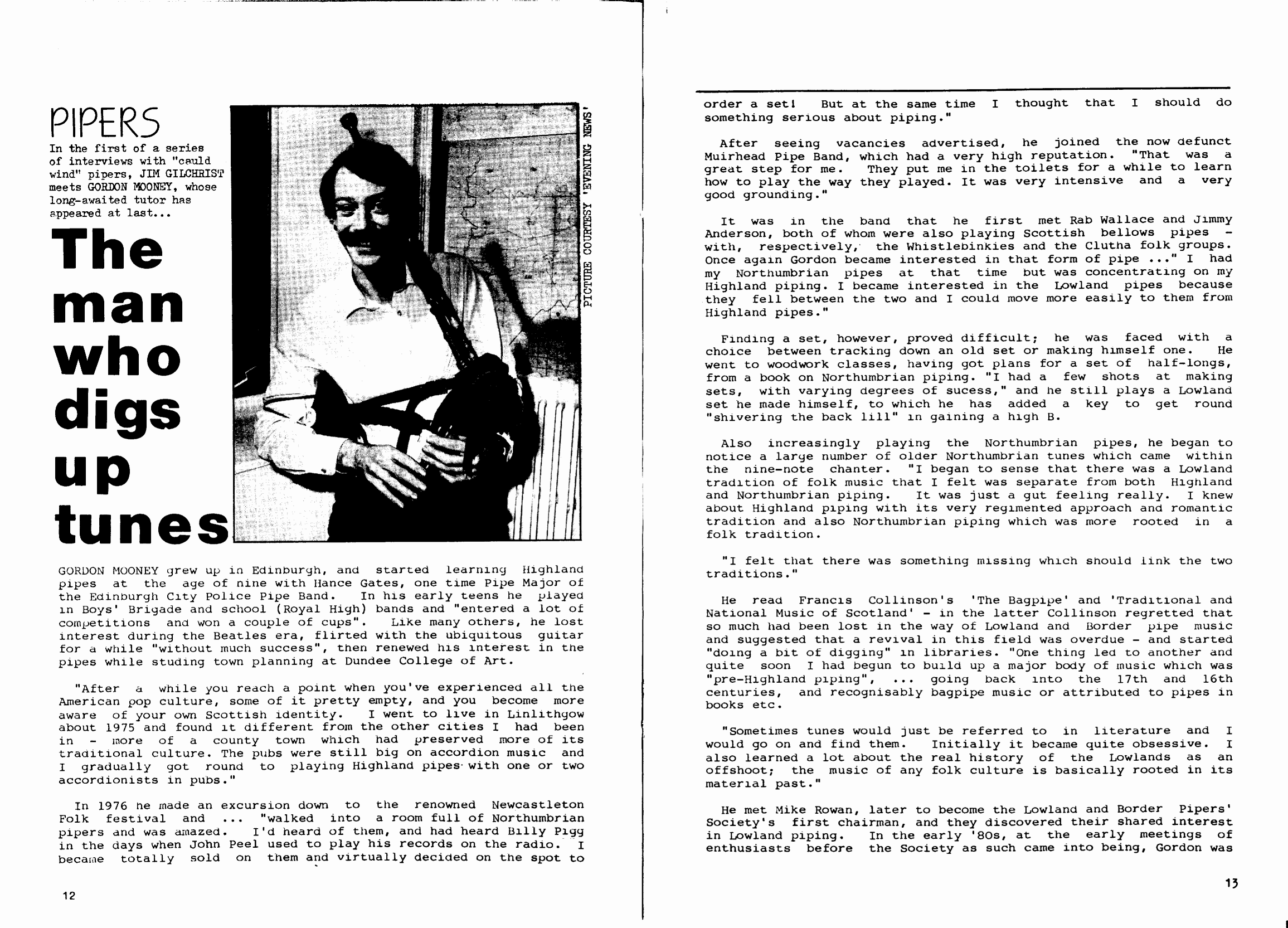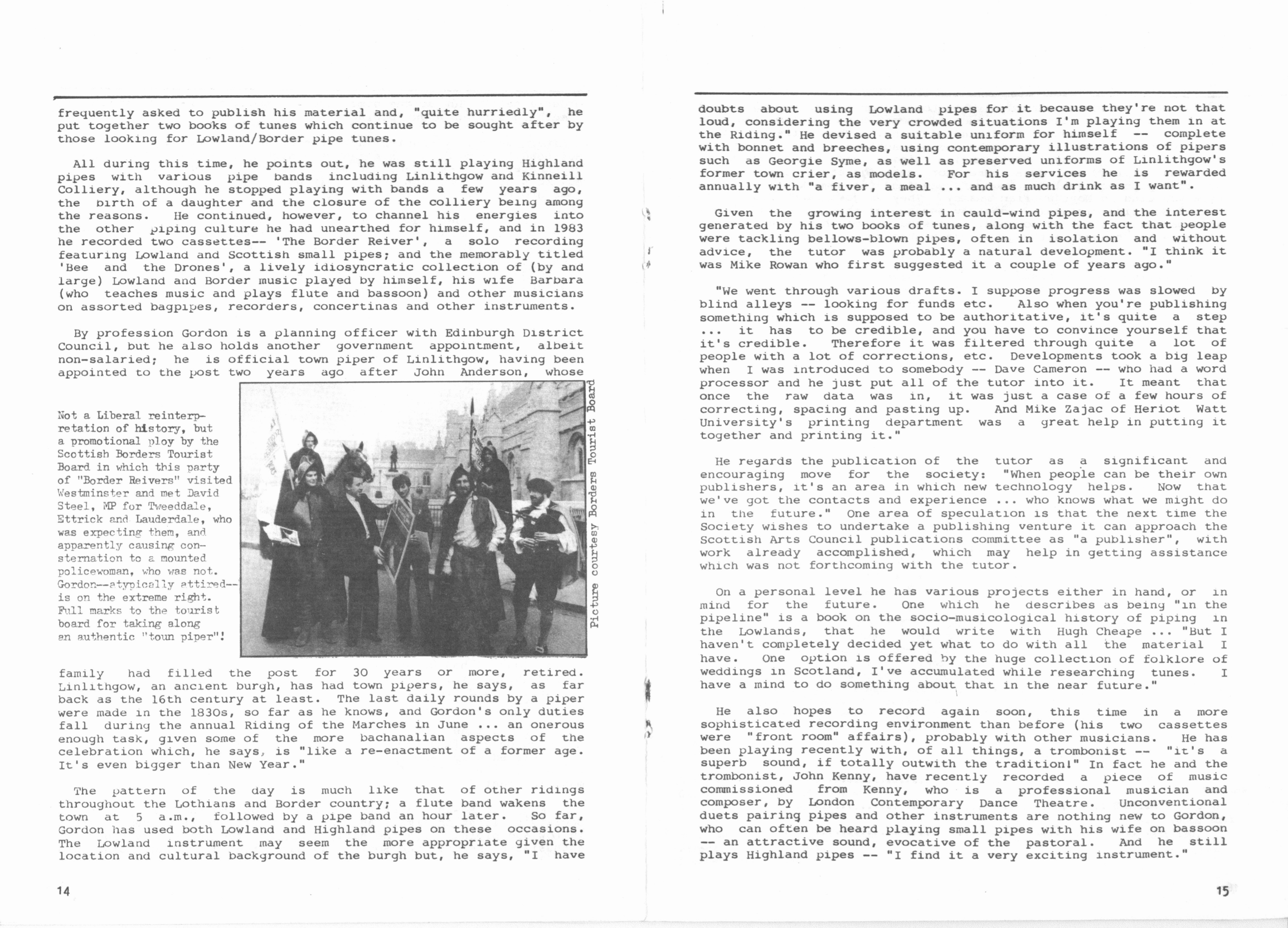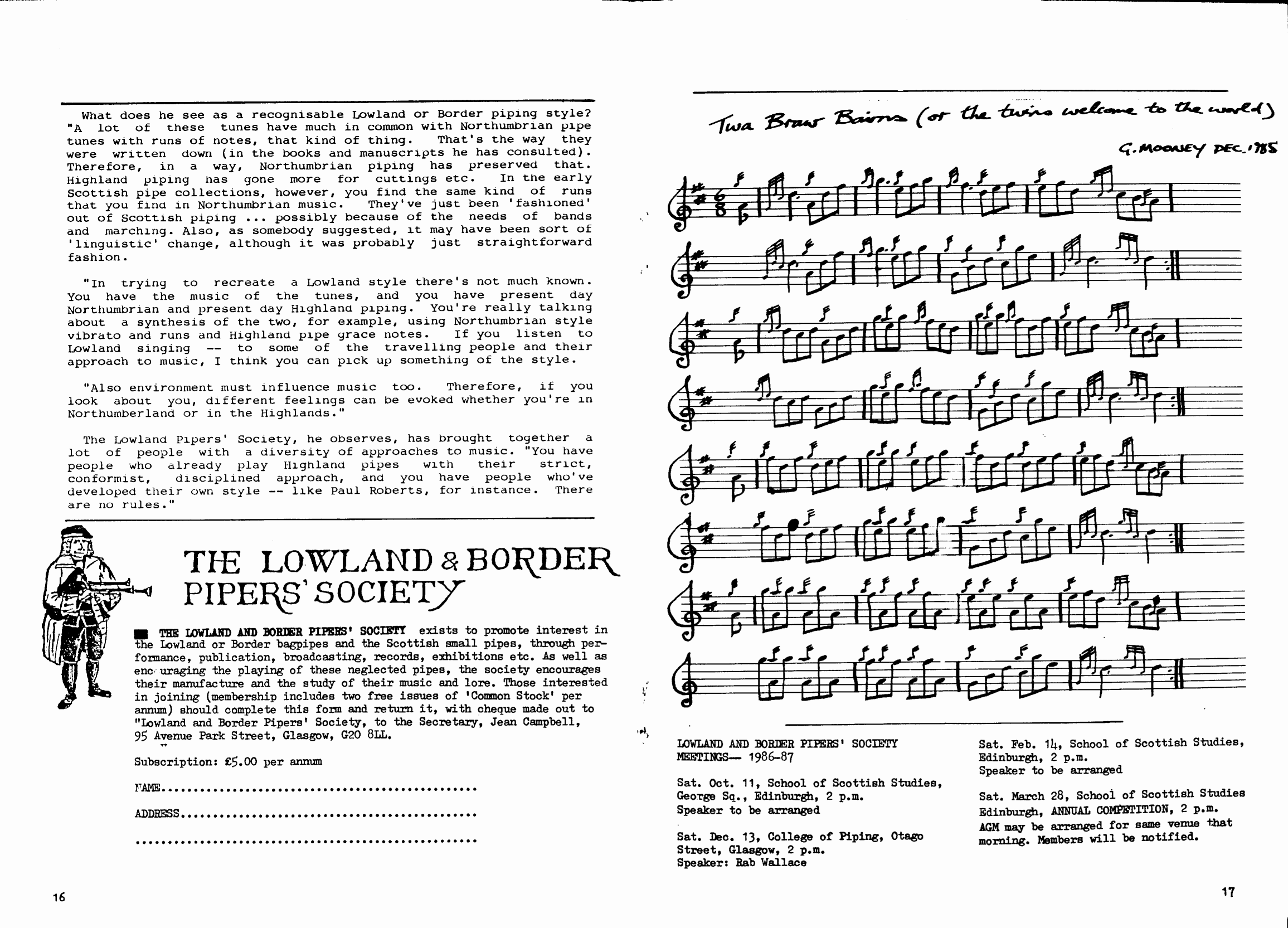Pipers: The Man Who Digs Up Tunes



In the first of 2 series of interviews with "cauld wind" pipers, JIM GILCHRIST meets GORDON MOONEY, whose long-awaited tutor has appeared at last...

GORDON MOONEY grew up in Edinburgh, and started learning Highland pipes at the age of nine with Hance Gates, one time Pipe Major of the Edinburgh City Police Pipe Band. In his early teens he played in Boys' Brigade and school (Royal High) bands and "entered a lot of competitions and won a couple of cups". Like many others, he lost interest during the Beatles era, flirted with the ubiquitous guitar for a while “without much success", then renewed his interest in the pipes while studying town planning at Dundee College of Art.
“After a while you reach a point when you've experienced all the American pop culture, some of it pretty empty, and you become more aware of your own Scottish identity. I went to live in Linlithgow about 1975 and found it different from the other cities I had been in - more of a county town which had preserved more of its traditional culture. The pubs were still big on accordion music and I gradually got round to playing Highland pipes: with one or two accordionists in pubs."
In 1976 he made an excursion down to the renowned Newcastleton Folk festival and ... “walked into a room full of Northumbrian pipers and was amazed. I'd heard of them, and had heard Billy Pigg in the days when John Peel used to play his records on the radio. I became totally sold on them and virtually decided on the spot to order a set! But at the same time I thought that if should do something serious about piping."
After seeing vacancies advertised, he joined the now defunct Muirhead Pipe Band, which had a very high reputation. "That was a great step for me. They put me in the toilets for a while to learn how to play the way they played. It was very intensive and a very good grounding."
It was in the band that he first met Rab Wallace and Jimmy Anderson, both of whom were also playing Scottish bellows pipes ~ with, respectively, the Whistlebinkies and the Clutha folk groups. Once again Gordon became interested in that form of pipe ..." I had my Northumbrian pipes at that time but was concentrating on my Highland piping. I became interested in the Lowland pipes because they fell between the two and I could move more easily to them from Highland pipes.”
Finding a set, however, proved difficult; he was faced with a choice between tracking down an old set or making himself one. He went to woodwork classes, having got plans for a set of half-longs, from a book on Northumbrian piping. "I had a few shots at making sets, with varying degrees of success," and he still plays a Lowland set he made himself, to which he has added a key to get round "shivering the back lill" in gaining a high B.
Also increasingly playing the Northumbrian pipes, he began to notice a large number of older Northumbrian tunes which came within the nine-note chanter. "I began to sense that there was a Lowland tradition of folk music that I felt was separate from both Highland and Northumbrian piping. It was just a gut feeling really. I knew about Highland piping with its very regimented approach and romantic tradition and also Northumbrian piping which was more rooted in a folk tradition.
"I felt that there was something missing which should link the two
traditions."
He read Francis Collinson's 'The Bagpipe" and ‘Traditional and National Music of Scotland' - in the latter Collinson regretted that so much had been lost in the way of Lowland and Border pipe music and suggested that a revival in this field was overdue - and started “doing a bit of digging" in libraries. "One thing led to another and quite soon I had begun to build up a major body of music which was “pre-Highland piping", ... going back into the 17th and 16th centuries, and recognisably bagpipe music or attributed to pipes in books etc.
"Sometimes tunes would just be referred to in literature and I would go on and find them. Initially it became quite obsessive. I also learned a lot about the real history of the Lowlands as an offshoot; the music of any folk culture is basically rooted in its material past."
He met Mike Rowan, later to become the Lowland and Border Pipers' Society's first chairman, and they discovered their shared interest in Lowland piping. In the early '80s, at the early meetings of enthusiasts before the Society as such came into being, Gordon was frequently asked to publish his material and, "quite hurriedly", he put together two books of tunes which continue to be sought after by those looking for Lowland/Border pipe tunes.
All during this time, he points out, he was still playing Highland pipes with various pipe bands including Linlithgow and Kinneill Colliery, although he stopped playing with bands a few years ago, the birth of a daughter and the closure of the colliery being among the reasons. He continued, however, to channel his energies into the other piping culture he had unearthed for himself, and in 1983 he recorded two cassettes-- ‘The Border Reiver', a solo recording featuring Lowland and Scottish small pipes; and the memorably titled ‘Bee and the Drones', a lively idiosyncratic collection of (by and large) Lowland and Border music played by himself, his wife Barbara (who teaches music and plays flute and bassoon) and other musicians on assorted bagpipes, recorders, concertinas and other instruments.
By profession Gordon is a planning officer with Edinburgh District Council, but he also holds another government appointment, albeit non-salaried; he is official town piper of Linlithgow, having been appointed to the post two years ago after John Anderson, whose family had filled the post for 30 years or more, retired. Linlithgow, an ancient burgh, has had town pipers, he says, as far back as the 16th century at least. The last daily rounds by a piper were made in the 1830s, so far as he knows, and Gordon's only duties fall during the annual Riding of the Marches in June ... an onerous enough task, given some of the more Bacchanalian aspects of the celebration which, he says, is "like a re-enactment of a former age. It's even bigger than New Year."
The pattern of the day is much like that of other ridings throughout the Lothians and Border country; a flute band wakens the town at 5 a.m., followed by a pipe band an hour later. So far, Gordon has used both Lowland and Highland pipes on these occasions. The Lowland instrument may seem the more appropriate given the location and cultural background of the burgh but, he says, "I have doubts about using Lowland pipes for it because they're not that loud, considering the very crowded situations I'm playing them in at the Riding." He devised a suitable uniform for himself -- complete with bonnet and breeches, using contemporary illustrations of pipers such as Geordie Syme, as well as preserved uniforms of Linlithgow's former town crier, as models. For his services he is rewarded annually with “a fiver, a meal ... and as much drink as I want".

Not a Liberal reinterpretation of history, but a promotional ploy by the Scottish Borders Tourist Board in which this party of "Border Reivers" visitedWestminster and met David Steel, MP for Tweeddale, Ettrick and Lauderdale, who was expecting them, and apparently causing consternation to two were not. Gordon--atypically attired--is on the extreme right. Full marks to the tourist board for taking along an authentic “toun piper"?
Given the growing interest in cauld-wind pipes, and the interest generated by his two books of tunes, along with the fact that people were tackling bellows-blown pipes, often in isolation and without advice, the tutor was probably a natural development. “I think it was Mike Rowan who first suggested it a couple of years ago."
“We went through various drafts. I suppose progress was slowed by blind alleys -- looking for funds etc. Also when you're publishing something which is supposed to be authoritative, it's quite a step.... it has to be credible, and you have to convince yourself that it's credible. Therefore it was filtered through quite a lot of people with a lot of corrections, etc.
Developments took a big leap when I was introduced to somebody -- Dave Cameron -- who had a word processor and he just put all of the tutor into it. It meant that once the raw data was in, it was just a case of a few hours of correcting, spacing and pasting up. And Mike Zajac of Heriot Watt University's printing department was a great help in putting it together and printing it.”
He regards the publication of the tutor as a significant and encouraging move for the society: “When people can be their own publishers, it's an area in which new technology helps. Now that we've got the contacts and experience ... who knows what we might do in the future." One area of speculation is that the next time the Society wishes to undertake a publishing venture it can approach the Scottish Arts Council publications committee as “a publisher", with work already accomplished, which may help in getting assistance which was not forthcoming with the tutor.
On a personal level he has various projects either in hand, or in mind for the future. One which he describes as being "in the pipeline" is a book on the socio-musicological history of piping in the Lowlands, that he would write with Hugh Cheape ... "But I haven't completely decided yet what to do with all the material I have. One option is offered by the huge collection of folklore of weddings in Scotland, I've accumulated while researching tunes. I have a mind to do something about that in the near future."
He also hopes to record again soon, this time in a more sophisticated recording environment than before (his two cassettes were "front room" affairs), probably with other musicians. He has been playing recently with, of all things, a trombonist -- “it's a superb sound, if totally outwith the tradition!" In fact he and the trombonist, John Kenny, have recently recorded a piece of music commissioned from Kenny, who is a professional musician and composer, by London Contemporary Dance Theatre. Unconventional duets pairing pipes and other instruments are nothing new to Gordon, who can often be heard playing small pipes with his wife on bassoon -- an attractive sound, evocative of the pastoral. And he still plays Highland pipes -- “I find it a very exciting instrument.”
What does he see as a recognisable Lowland or Border piping style? "A lot of these tunes have much in common with Northumbrian pipe tunes with runs of notes, that kind of thing. That's the way they were written down (in the books and manuscripts he has consulted). Therefore, in a way, Northumbrian piping has preserved that.
Highland piping has gone more for cuttings etc. In the early Scottish pipe collections, however, you find the same kind of runs that you find in Northumbrian music. They've just been 'fashioned' out of Scottish piping ... possibly because of the needs of bands and marching. Also, as somebody suggested, 1t may have been sort of ‘Linguistic’ change, although it was probably just straightforward fashion.
“In trying to recreate a Lowland style there's not much known. You have the music of the tunes, and you have present day Northumbrian and present day Highland piping. You're really talking about a synthesis of the two, for example, using Northumbrian style vibrato and runs and Highland pipe grace notes. If you listen to Lowland singing -- to some of the travelling people and their approach to music, I think you can pick up something of the style. "Also environment must influence music too. Therefore, if you look about you, different feelings can be evoked whether you're in Northumberland or in the Highlands.”
The Lowland Pipers’ Society, he observes, has brought together a lot of people with a diversity of approaches to music. “You have people who already play Highland pipes with their strict, conformist, disciplined approach, and you have people who've developed their own style -- like Paul Roberts, for instance. There are no rules."
